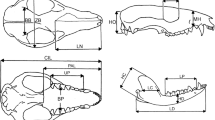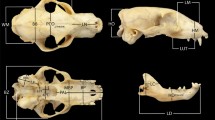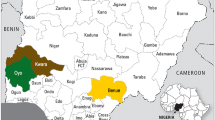Abstract
The cranial ontogeny of specialized mammals is relevant to the understanding of the connection of form and function in a developmental, ecological, and evolutionary context. As highly specialized carnivores, felids are of especial interest. We studied the postnatal ontogeny of the skull in Puma concolor (Mammalia: Carnivora: Felidae) using a quantitative approach. We interpreted our results in the light of a previous qualitative assessment of ontogenetic changes in the species. This represents one of the few integrative studies of skull development in any extant species of wild felids. We report patterns of multivariate allometry of 19 linear skull dimensions measured in 48 Argentine specimens. We examined the (jackknife resampled) departures from isometry as well as the interplay of isometric and allometric trends in shaping the puma skull. Both the qualitative and quantitative results indicate that the major ontogenetic changes are directly linked to cranial structures that support a developing masticatory apparatus and its associated jaw and neck musculature, which are essential for the action of canines and carnassials during the killing bite and slicing flesh. Sexual differences suggest allometric scaling (hypo- or hyper-morphosis) as key processes in the development of the puma skull.
Similar content being viewed by others
References
Abdala, F., Flores, D.A., Giannini, N.P., 2001. Post-weaning ontogeny in the skull in Didelphis albiventris. Journal of Mammalogy 82, 190–200.
Antón, M., Salesa, M.J., Pastor, J.F., Sánchez, I.M., Fraile, S., Morales, J., 2004. Implications of the mastoid anatomy of larger extant felids for the evolution and predatory behaviour of Sabretoothed cats (Mammalia, Carnivora, Felidae). Zoological Journal of the Linnean Society 140, 207–221.
Biknevicius, A.R., Leigh, S.R., 1997. Patterns of growth of the mandibular corpus in spotted hyenas (Crocuta crocuta) and cougars (Puma concolor). Zoological Journal of the Linnean Society 120, 139–161.
Biknevicius, A.R., van Valkenburgh, B., 1996. Design for killing: craniodental adaptations of predators. In: Gittleman, J.L. (Ed.), Carnivore Behavior, Ecology, and Evolution. Cornell University Press, New York, pp. 393–428.
Biknevicius, A.R., van Valkenburgh, B., Walker, J., 1996. Incisor size and shape: implications for feeding behaviors in saber-toothed ‘cats’. Journal of Vertebrate Paleontology 16, 510–521.
Biknevicius, A.R., 1996. Functional discrimination in the masticatory apparatus of juvenile and adult cougars (Puma concolor) and spotted hyenas (Crocuta crocuta). Canadian Journal of Zoology 74, 1934–1942.
Binder, W.J., van Valkenburgh, B., 2000. Development of bite strength and feeding behavior in juvenile spotted hyenas (Crocuta crocuta). Journal of Zoology 252, 273–283.
Broom, R., 1949. Notes on the milk dentition of the lion, leopard and cheetah. Annals of the Transvaal Museum 21, 183–185.
Bryant, H.N., 1988. Delayed eruption of the deciduous upper canine in the sabretoothed carnivore Barbourofelis lovei (Carnivora, Nimravidae). Journal of Vertebrate Paleontology 8, 295–306.
Bryant, H.N., 1990. Implications of the dental eruption sequence in Barbourofelis (Carnivora, Nimravidae) for the function of upper canines and the duration of parental care in sabertoothed carnivores. Journal of Zoology 222, 585–590.
Caro, T.M., 1994. Cheetahs of the Serengeti Plains: Group Living in an Asocial Species. University of Chicago Press, Chicago.
Christiansen, P., 2008. Evolution of Skull and Mandible Shape in Cats (Carnivora: Felidae). PloS One 3 (7), e2807.
Christiansen, P., Adolfssen, J.S., 2005. Bite forces, canine strength and skull allometry in carnivores (Mammalia, Carnivora). Journal of Zoology 266, 133–151.
Christiansen, P., Harris, J.M., 2005. Body size of Smilodon (Mammalia: Felidae). Journal of Morphology 266, 369–384.
Collier, G.E., O’Brien, S.J., 1985. A molecular phylogeny of the Felidae: immunological distance. Evolution 39, 473–487.
Crowe, D.M., 1975. Aspects of ageing, growth, and reproduction of bobcats from Wyoming. Journal of Mammalogy 56, 177–198.
Currier, M.J.P., 1979. An age estimation technique and some normal blood values for mountain lions (Felis concolor). Colorado State University, Unpublished Ph.D. Dissertation.
Currier, M.J.P., 1983. Felis concolor. Mammalian species 200, 1–7.
Duckler, G.L., 1998. An unusual osteological formation in the posterior skulls of captive tigers (Panthera tigris). Zoo Biology 17, 135–142.
Eaton, R.L., Verlander, K.A., 1977. Reproduction in the puma: biology, behavior and ontogeny. In: Eaton, R.L. (Ed.), The World’s Cats. Carnivore Research Institute, Burke Museum, University of Washington, Seattle, pp. 45–70.
Emerson, S.B., Bramble, D.M., 1993. Scaling, allometry and skull design. In: Hanken, J., Hall, B.K. (Eds.), The Skull. The University of Chicago Press, Chicago, pp. 384–416.
Emerson, S.B., Hastings, P.A., 1998. Morphological correlations in evolution: consequences for phylogenetic analysis. Quarterly Review of Biology 73, 141–162.
Emerson, S.B., Radinsky, L., 1980. Functional analysis of sabertooth cranial morphology. Paleobiology 6, 295–312.
Evans, H.E., 1993. Miller’s Anatomy of the Dog. W.B. Saunders Company, Philadelphia.
Ewer, R., 1973. The Carnivores. Cornell University Press, Ithaca.
Fagen, R.M., Wiley, K.S., 1978. Felid paedomorphosis, with special reference to Leopardus. Carnivore 1, 72–81.
Fink, W.L., 1982. The conceptual relationship between ontogeny and phylogeny. Paleobiology 8, 254–264.
Flores, D.A., Giannini, N.P., Abdala, F., 2003. Cranial ontogeny on Lutreolina crassicaudata (Didelphidae): a comparison with Didelphis albiventris. Acta Theriologica 48, 1–9.
Flores, D.A., Giannini, N.P., Abdala, F., 2006. Comparative postnatal ontogeny of the skull in an Australidelphian Metatherian, Dasyurus albopunctatus (Marsupialia: Dasyuromorpha: Dasyuridae). Journal of Morphology 267, 426–440.
García-Perea, R., 1996. Patterns of postnatal development in skulls of Lynxes, Genus Lynx (Mammalia: Carnivora). Journal of Morphology 229, 241–254.
García-Perea, R., 2002. Andean mountain cat, Oreailurus jacobita: morphological description and comparison with other felines from the altiplano. Journal of Mammalogy 83, 110–124.
Gay, S.W., Best, T.L., 1996. Age-related variation in skulls of the puma (Puma concolor). Journal of Mammalogy 77, 191–198.
Giannini, N.P., Abdala, F., Flores, D.A., 2004. Comparative postnatal ontogeny of the skull in Dromiciops gliroides (Marsupialia: Microbiotheriidae). American Museum Novitates 3460, 1–17.
Gilbert, S.G., 1997. Pictorial Anatomy of the Cat. University of Washington Press, Seattle.
Goswami, A., 2006. Morphological integration in the carnivoran skull. Evolution 60, 169–183.
Hollister, N., 1917. Some effects of environment and habit on captive lions. Proceedings of the United States National Museum 53, 177–193.
Jackson, D.L., Gluesing, E.A., Jacobson, H.A., 1988. Dental eruption in bobcats. Journal of Wildlife Management 52, 515–517.
Johnson, W.E., O’Brien, S.J., 1997. Phylogenetic reconstruction of the Felidae using 16S rRNA and NADH-5 mitochondrial genes. Journal of Molecular Evolution 44, 98–116.
Johnson, N.F., Brown, B.A., Bosomworth, J.C., 1981. Age and sex characteristics of bobcat canines and their use in population assessment. Wildlife Society Bulletin 9, 202–206.
Jolicoeur, P., 1963a. The multivariate generalization of the allometry equation. Biometrics 19, 497–499.
Jolicoeur, P., 1963b. The degree of generality of robustness in Martes americana. Growth 27, 1–27.
Kelson, K.R., 1946. Notes on the comparative osteology of the bobcat and house cat. Journal of Mammalogy 27, 255–264.
Kitchener, A., 1991. The Natural History of the Wild Cats. Cornell University Press, Ithaca.
Laundré, J.W., Hernández, L., Streubel, D., Altendorf, K., González, C.L., 2000. Aging mountain lions using gum-line recession. Wildlife Society Bulletin 28, 963–966.
Manly, B.F.J., 1997. Randomization, Bootstrap, and Monte Carlo Methods in Biology. Chapman & Hall, London.
Marroig, G., Cheverud, J.M., 2004. Cranial evolution in sakis (Pithecia, Platyrrhini) I: interspecific differentiation and allometric patterns. American Journal of Physical Anthropology 125, 266–278.
Martin, L.D., 1980. Functional morphology and the evolution of cats. Transactions of the Nebraska Academy of Science 8, 141–154.
Mattern, M.Y., McLennan, D.A., 2000. Phylogeny and speciation of felids. Cladistics 16, 232–253.
Mazák, J.H., Groves, C.P., 2006. A taxonomic revision of the tigers (Panthera tigris) of Southeast Asia. Mammalian Biology 71, 268–287.
Myers, P., 2000. Carnivora (on-line). Animal Diversity Web. Available at <http://animaldiversity.ummz.umich.edu>.
Nowak, R.M., 1999. Walker’s Mammals of the World. Johns Hopkins University Press, Baltimore.
O’Reagan, H.J., Kitchener, A.C., 2005. The effects of captivity on the morphology of captive, domesticated and feral mammals. Mammal Review 35, 215–230.
O’Regan, H.J., 2001. Morphological effects of captivity in big cat skulls. In: Wehnelt, S., Hudson, C. (Eds.), Proceedings of the 3rd Zoo Research Symposium. Chester Zoo, Chester, pp. 18–22.
Olson, E.C., Miller, R.L., 1958. Morphological Integration. University of Chicago Press, Chicago.
Peigné, S., de Bonis, L., 2003. Juvenile cranial anatomy of Nimravidae (Mammalia, Carnivora): biological and phylogenetic implications. Zoological Journal of the Linnean Society 138, 477–493.
Petersen, M.K., Petersen, M.K., 1978. Growth rate and other postnatal developmental changes in margays. Carnivore 1, 87–92.
Quenouille, M.H., 1956. Notes on bias in estimation. Biometrika 43, 353–360.
R Development Core Team, 2004. R: a language and environment for statistical computing. Vienna: R Foundation for Statistical Computing. <http://www.Rproject.org>.
Reilly, S.M., Wiley, E.O., Meinhardt, D.J., 1997. An integrative approach to heterochrony: the distinction between interspecific and intraspecific phenomena. Biological Journal of the Linnean Society 60, 119–143.
Richmond, F.J.R., Thomson, D.B., Loeb, G.E., 1992. Electromyographic studies of neck muscles in the intact cat. Experimental Brain Research 88, 41–58.
Salles, L.O., 1992. Felid phylogenetics: extant taxa and skull morphology (Felidae, Aeluroidea). American Museum Novitates 3047, 1–67.
Segura, V., Flores, D.A., 2009. Aproximación cualitativa y aspectos funcionales en la ontogenia craneana de Puma concolor (Felidae). Mastozoologí Neotropical 16, 169–182.
Shaw, H.G., Beier, P., Culver, M., Grigione, M., 2007. Puma Field Guide. The Cougar Network.
Slater, G.J., van Valkenburgh, B., 2008. Long in the tooth: evolution of sabertooth cat cranial shape. Paleobiology 34 (3), 403–419.
Slaughter, B.H., Pine, R.H., Pine, N.E., 1974. Eruption of cheek teeth in Insectivora and Carnivora. Journal of Mammalogy 55, 115–125.
Stander, P.E., 1997. Field age determination of leopards by tooth wear. African Journal of Ecology 35, 156–161.
Stehlik, J., 1971. Breeding jaguars Panthera onca at Ostrava Zoo. International Zoo Yearbook 11, 116–118.
Stuart, C.H.T., Stuart, T.D., 1985. Age determination and development of foetal and juvenile Felis caracal Schreber, 1776. Säugertierkunde Mitteilungen 32, 217–229.
Tukey, J.W., 1956. Bias and confidence in not quite large samples. Annals of Mathematics and Statistic 23, 614.
van Valkenburgh, B., 1990. Skeletal and dental predictors of body mass in carnivores. In: Damuth, J., Macfadden, B.J. (Eds.), Body Size in Mammalian Paleobiology: Estimation and Biological Implications. Cambridge University Press, Cambridge, pp. 181–205.
Vermeij, G.J., 1973. Adaptation, versatility, and evolution. Systematic Zoology 22, 466–477.
Volf, J., 1972. Exigences alimentaires et dentition des jeunes de trois especes de felides. Mammalia 36, 683–686.
Wagner, G.P., 1996. Homologues, natural kinds and the evolution of modularity. American Zoologist 36, 36–43.
Wickland, C.R., Baker, J.F., Paterson, B.W., 1991. Torque vectors of neck muscles in the cat. Experimental Brain Research 84, 649–659.
Ximénez, A., 1974. Notas sobre Félidos Neotropicales, VI. Contributión a la elucidatión de las variaciones individuales de Felis pardalis Linne, 1758 (Mammalia, Felidae). Comunicaciones del Museo Argentino de Ciencias Naturales “Bernardino Rivadavia” e Instituto Nacional de Investigación de las Ciencias Naturales 4, 41–55.
Author information
Authors and Affiliations
Corresponding author
Rights and permissions
About this article
Cite this article
Giannini, N.P., Segura, V., Giannini, M.I. et al. A quantitative approach to the cranial ontogeny of the puma. Mamm Biol 75, 547–554 (2010). https://doi.org/10.1016/j.mambio.2009.08.001
Received:
Accepted:
Published:
Issue Date:
DOI: https://doi.org/10.1016/j.mambio.2009.08.001




